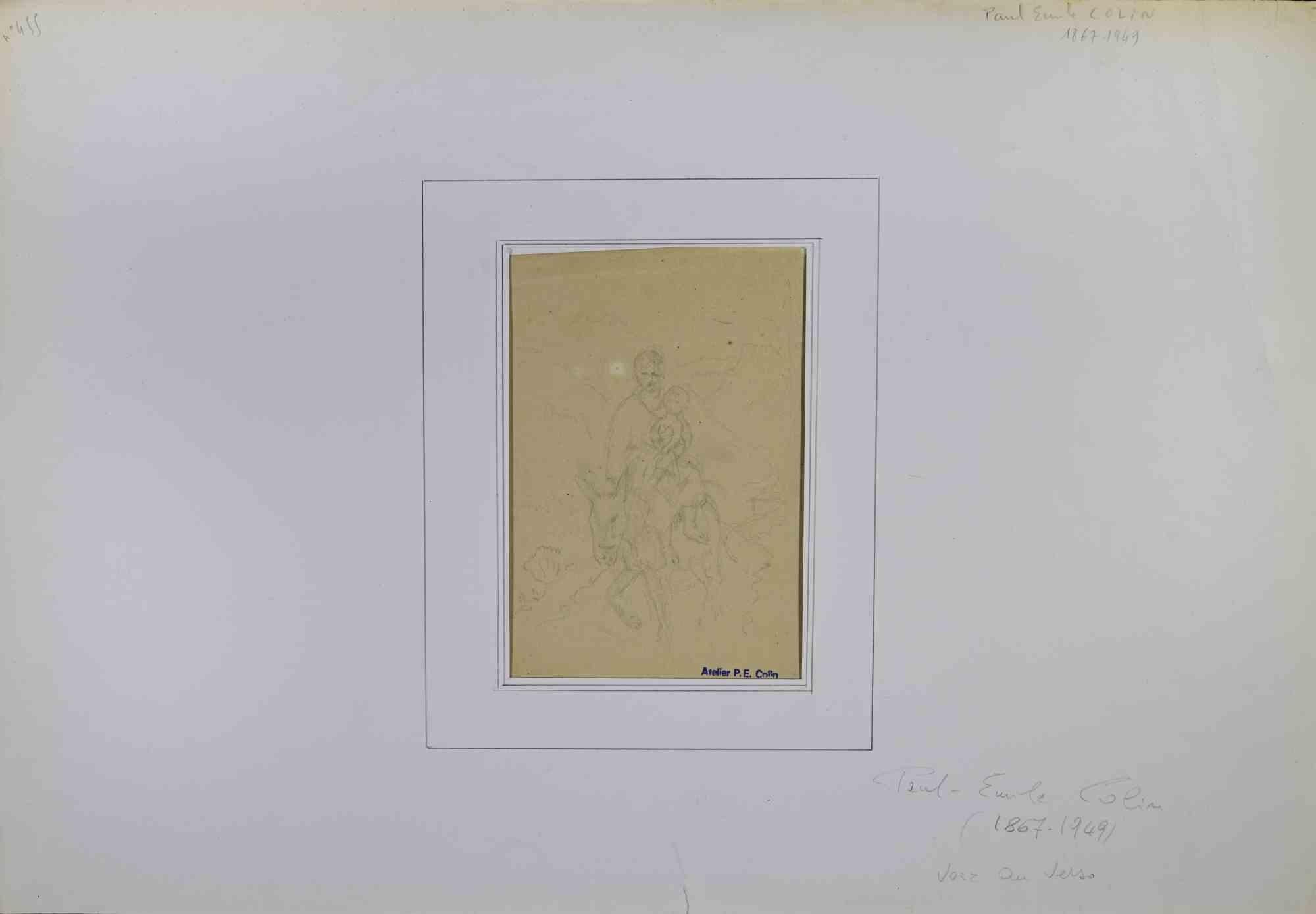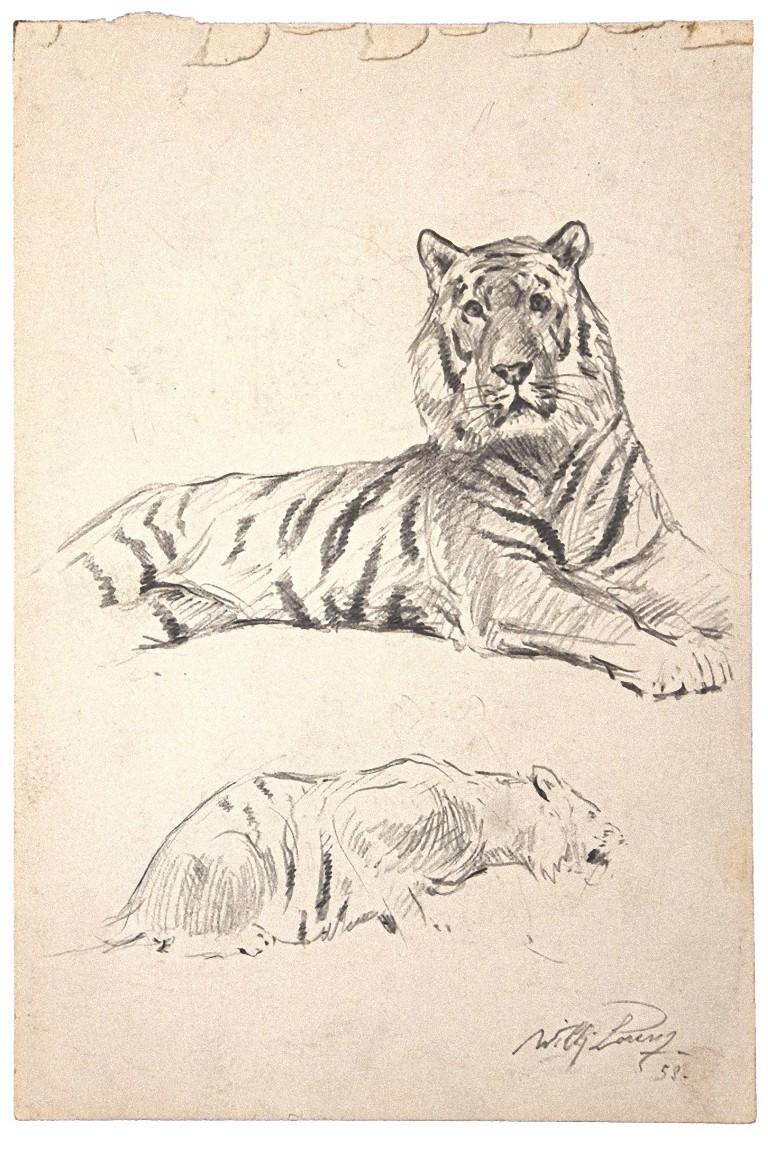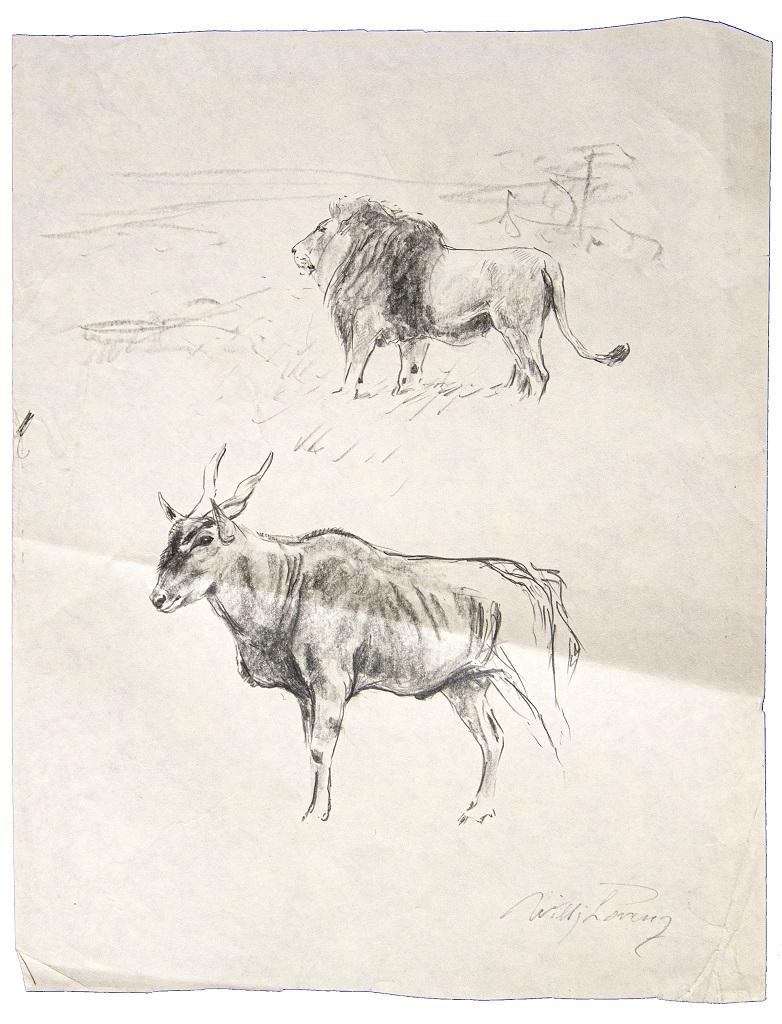Items Similar to Couple of Deers - Original Pencil Drawing by Ernest Rouart - Early 1900
Want more images or videos?
Request additional images or videos from the seller
1 of 2
Ernest RouartCouple of Deers - Original Pencil Drawing by Ernest Rouart - Early 1900Early 1900
Early 1900
About the Item
Couple of Deers is an original drawing realized by Ernest Rouart in the early XX Century. Pencil on paper; signed on the lower right margin. The back of the artwork is sketched in pencil. Passepartout included (49 x 34 cm). Very good conditions.
Very nice sketch representing a couple of little cute deers. The softness and the elegance of the contour lines reflect the great talent of Rouart, especially in the representation of animals. The proportions of the bodies are precise, clear, and simple. The artist realized many different sketches with deers and other animals in different poses.
Ernest Rouart (Paris, 1874 – Paris, 1942) was a French painter, illustrator, engraver, and art collector.
He was the son of Henri Rouart and the brother of Eugène Rouart. He married Julie Manet, the daughter of Berthe Morisot and Eugène Manet. With her wife, he offered many artworks to the Musée du Louvre and the Musée d’Orsay, and contributed to promote Manet's, Degas's, and Morisot's artworks with important exhibitions. He studied mathematics, but he soon changed his mind and decided to dedicate himself to art and to painting in particular. Edgar Degas, who was one of the closest friends of Ernest Rouart, introduced him to painting. Degas introduced him to Julie Manet, who eventually became his wife; they lived at Rue de Villejust, where also Jeanne Gobillard and her husband Paul Valéry, a friend of Degas, lived. Ernest Rouart was also an important art collector: he acquired many Impressionist collections and, during the War, he obtained the permission to sell Degas's works. In 1899, he participated in the Société Nationale des Beaux-Arts, the Salon des Indépendants, and the Salon of the Teilleries.
This artwork is shipped from Italy. Under existing legislation, any artwork in Italy created over 70 years ago by an artist who has died requires a licence for export regardless of the work’s market price. The shipping may require additional handling days to require the licence according to the final destination of the artwork.
- Creator:Ernest Rouart (1874 - 1942)
- Creation Year:Early 1900
- Dimensions:Height: 9.85 in (25 cm)Width: 16.34 in (41.5 cm)Depth: 0.04 in (1 mm)
- Medium:
- Period:
- Framing:Framing Options Available
- Condition:Insurance may be requested by customers as additional service, contact us for more information.
- Gallery Location:Roma, IT
- Reference Number:
About the Seller
4.9
Platinum Seller
These expertly vetted sellers are 1stDibs' most experienced sellers and are rated highest by our customers.
1stDibs seller since 2017
6,753 sales on 1stDibs
Typical response time: 2 hours
- ShippingRetrieving quote...Ships From: Grasse, France
- Return PolicyA return for this item may be initiated within 14 days of delivery.
More From This SellerView All
- The Donkey - Drawing by Paul Emile Colin - Early-20th centuryLocated in Roma, ITThe Donkey is an artwok realized by the French Artist Paul Emile Colin . Pencil Drawing on paper. Signed on plate "Atelier P.E. Colin" on the right corner. ...Category
Early 20th Century Modern Animal Drawings and Watercolors
MaterialsPencil
- Study of Figures - Ink and Pencil Drawing by M. Dumas - Mid 19th CenturyLocated in Roma, ITStudy of Figures includes two original drawings in china ink and pencil on paper realized by Michel Dumas (1812-1885), with the stamp of the artist on the rear. One of them is a nude...Category
Mid-19th Century Figurative Drawings and Watercolors
MaterialsPencil, Ink
- Vulture - Pencil and Pastel Drawing by Jane Le Soudier - Mid 20th CenturyBy Jane Le SoudierLocated in Roma, ITVulture is an original drawing in pencil and pastel realized Jane Le Soudier (1885-1976). with the monogram of the artist's name on the lower right. The state of preservation of the ...Category
Mid-20th Century Figurative Drawings and Watercolors
MaterialsPencil, Pastel
- Head of Lion - l Pencil Drawing by Etha Richter - 1930sBy Etha RichterLocated in Roma, ITLion is an original pencil drawing by the German artist Etha Richter (Dresda,1883 - Dresda,1977). Hand-signed in lead on the lower right: Etha Richter - Dresden. On the paper in w...Category
1930s Animal Drawings and Watercolors
MaterialsPencil
- Study of a Tiger - Pencil on Paper by Wilhelm Lorenz -Late 20th CenturyBy Wilhelm LorenzLocated in Roma, ITStudy of a tiger is a beautiful original drawing in pencil on ivory-colored paper realized in the XX century by the German artist Wilhelm Lorenz, also known as Willi Lorenz. This i...Category
20th Century Figurative Drawings and Watercolors
MaterialsPencil
- Gnu and Lion - Pencil on Paper by Wilhelm Lorenz - Mid-20th CenturyBy Wilhelm LorenzLocated in Roma, ITGnu and lion is a beautiful original drawing in pencil on ivory-colored paper realized in the XX century by the German artist Wilhelm Lorenz, also known as Willi Lorenz. This is a ...Category
Mid-20th Century Figurative Drawings and Watercolors
MaterialsPencil
You May Also Like
- Predatory Animals - Drawing, Pink, Animals, Orange, SurrealistBy Raluca ArnăutuLocated in Berlin, DEPredatory Animals, 2014 acryl, pencil and black fineliner on paper 13.89 H x 19.68 W in 35.3 H x 50 W cm Raluca Arnăutu creates a zoomorphic world, whe...Category
2010s Surrealist Animal Drawings and Watercolors
MaterialsPaper, Color Pencil
- Horse II - 21st Century, Figurative Drawing, Animal, Colored Pencil, BrownBy Dinu RădulescuLocated in Berlin, DEHorse II, 2014 Colored Pencil on Paper 28.74 H x 40.15 W in. 73 H x 102 W cm Dinu Rădulescu's drawings illustrate, in their majority, the Horse, like a...Category
2010s Expressionist Animal Drawings and Watercolors
MaterialsPaper, Pencil, Color Pencil
- Art deco mixed media on paper - Panther in a forest of bamboos by Gaston SuisseLocated in Carouge GE, GEPanthère dans les bambous, 1926 Gouache, or et traits de crayon sur papier Signé et daté en bas à droite 15 x 15 cm (sujet) Panther in the bamboos, 1926 Gouache, pencil and gold on paper Signed and dated to the lower right Provenance Collection particulière, France - Private collection, France Bibliographie/Literature : Emmanuel Bréon "Gaston Suisse, splendeur du laque art déco", Somogy Editions d'art, Paris 2013, oeuvre décrite et reproduite page 104. (l’oeuvre décrite et reproduite est la lithographie tirée d'après l’oeuvre originale que nous présentons.) Nous présentons ici l'oeuvre originale à la gouache, or et crayon de la panthère noire. L’artiste en réalisa une gravure sur bois dont il tira lui-même une vingtaine d’épreuve. Ces épreuves ne furent pas commercialisées telles quelles, Gaston Suisse reprit chacune des épreuves en utilisant des lavis d’encre de Chine et des ors de différentes couleurs, afin d’obtenir des effets différents pour chaque épreuve, qui sont donc des œuvres originales uniques. We present here the original work in gouache, gold and pencil of the black panther. From this original, the artist made a wood engraving of which he made about twenty prints himself. These proofs were not marketed as they were, Gaston Suisse reworked each of the proofs using Indian ink washes and golds of different colors, in order to obtain different effects for each proof, which are thus unique original works. Born in 1896 in a family of artists, his father Georges was a close friend of Siegfried Bing and a great lover of Japanese art and a bibliophile. He passed his taste for art to his son whom he often took to draw at the Botanic Garden . Around 1910, Gaston Suisse, who hasn't entered yet the artistic school, met Paul Jouve, then 18 years his elder, who was already famous. In 1911, at the age of 17, he entered the National School of Decorative Art where he followed the teachings of Paul Renouard. Thanks to his knowledge and taste for the Japanese art, he chose lacquer painting as his specialty. His practice of this noble and demanding subject were so much appreciated that he was awarded with two gold medals in 1913 and 1914. Mobilized during the war , he joined the army and go in Salonika where he found his friend Jouve. In 1918, he finished his studies at the School of Applied Arts in order to perfect his training. He learned in particular the techniques of gilding and oxidation of metals. The first productions of Gaston Suisse, furniture and objects in lacquer with geometrical patterns, were an instant success and Suisse was appointed as member of Salon d'Automne in 1924, the very year of his first exhibition. Considered as an artist-decorator, his sincere and deep friendship with Jouve linked him in parallel with the groups of the animaliers of the Jardin des Plantes and became a close friend of Edouard-Marcel Sandoz. When travelling to Maghreb and Middle-East between 1923 and 1925, he produced numerous drawings representing antelopes, apes and fennec foxes...Category
1920s Art Deco Animal Drawings and Watercolors
MaterialsGold
- Vigilant Fox - The psyche of the fox -Located in Berlin, DECarl Friedrich Deiker (1838 Wetzlar - 1892 Düsseldorf). Vigilant fox. Pencil drawing on brown paper, 18 × 29.5 cm (inside measurement), 31.5 x 43.5 cm (mount), signed and dated "Deiker [18]54" at lower right. - a little bit stained, with a light water stain at lower right About the artwork Carl Friedrich Deiker's consummate ability to depict animals is already evident in this early work. He brought a whole new psychological dimension to animal painting, so that one could literally speak of animal portraits. The naturalistic appearance of the fox alone makes it seem alive. Every strand of muscle, even every hair, is captured, which requires an intensive artistic study of animal anatomy and physiology. But the fox's real liveliness comes not from its natural appearance, but from its internal movement: Stretched out, it has been brought out of rest. It turns around and, with its ears pricked up, looks intently in the direction from which it has seen something. His mouth is slightly open and his pointed teeth are bared, as if he were growling. Tension gradually takes hold of his whole body. While the hind legs were still in a relaxed position, closely observed by Deiker, one front leg was already raised, ready to begin a rising movement. The fox seems so alarmed with all its senses that one gets the impression that, at any moment, its tail will move jerkily and the animal will jump up. While wild animals have traditionally been portrayed as beasts or anthropomorphised, often for caricatural purposes, Deiker explores their inherent nature by attempting to capture their psychic impulses. The wild animal is neither bestial nor human, but a creature in its own right, valued by Deiker for its own sake. In this way, he brought the dignity of the animal into representation and raised animal painting to a whole new artistic level. About the artist Carl Friedrich Deiker was the son of the drawing teacher Christian Friedrich Deiker and the younger brother of the animal painter Johannes Deiker. In addition to the family art lessons, Christian Friedrich shared a studio with his brother Johannes at Braunfels Castle, Deiker attended the drawing academy in Hanau, and from 1858 he was a student at the Karlsruhe Art Academy, where he studied under the landscape painter Johann Wilhelm Schirmer. Carl Friedrich Deiker was already in demand as an artist during his first year: Grand Duke Frederick I of Baden, Margrave Max of Baden and Grand Duke Michael of Russia bought hunting scenes by him. In 1859 he went on a study trip to the Reinhardswald. Just as the Barbizon School had rediscovered the landscape, Deiker opened up the forest for animal painting. From 1861-64 Deiker had his own studio in Karlsruhe, then moved to Düsseldorf, where his brother Johannes followed four years later. Deiker married a daughter of the landscape painter Karl Hilger and remained in Düsseldorf until his death. In 1868 he finally achieved international fame with his painting 'Pursued Noble Deer' and was regarded as a virtuoso new founder of animal painting. "Deiker brought for the first time a truly great artistic quality to animal painting [...]". - Hans Vollmer From 1870 he participated in the academic art exhibitions in Berlin, Dresden, Munich and Hanover. He was also very busy as an illustrator. He drew for the Gartenlaube, the Salon, the Universum, and produced many of the finely illustrated hunting and animal books of the period. He also worked as a printmaker, while his oil paintings circulated as reprints by Franz Dinger. From 1865 to 1892 Deiker was a member of the artists' association Malkasten. Carl Friedrich Deiker's life's work was honoured with a large posthumous memorial exhibition at the Düsseldorf Kunsthalle in 1892. His son Carl Deiker, born in 1879, also became a painter. Selection of art museums that own works by Carl Friedrich Deiker: Hamburger Kunsthalle / Kunsthalle Karlsruhe / Kunstmuseum Düsseldorf / Wallraff Richartz Cologne. Selected Bibliography H. Schmidt: Johannes and...Category
1850s Naturalistic Animal Drawings and Watercolors
MaterialsPencil
- Feeding the Kittens - Little cat mother -Located in Berlin, DEErnst Albert Fischer-Cörlin (1853 Körlin - 1932 Persante). Feeding the Kittens, 1893. Pencil on painting cardboard, 38 x 29 cm. Signed and dated by the artist at lower left "E[rnst] A[lbert] Fischer=Cörlin 1893". - Lightly stained, somewhat dusty and minimally foxed. - Little cat mother - About the artwork Daughter, mother and grandmother gather in the sunlight to feed a litter of kittens. The mother and grandmother hold the lively, playful animals in their arms, while the young girl feeds two of the four kittens with cookies. There is also a small bucket of milk and a bowl of milk. The women and the girl watch as the cute, still blind animals eat. It is a scene taken from everyday life, but it also has an allegorical dimension, bringing maternal care into the representation. Three generations are represented, with the grandmother and the mother already mothers. They not only offer the kittens to the youngest, but also proudly observe the maternal care that the youngest gives to the kittens. Like the kittens, she will grow up and become a mother herself, so the image is also an allegory of life's ever-new beginnings. In keeping with this, the morning sun shines into the picture from the right. Fischer-Cörlin has masterfully worked out the quality of the light, with its light and dark areas, with the pencil used...Category
1890s Academic Animal Drawings and Watercolors
MaterialsCardboard, Carbon Pencil
- Study of a buffaloBy Victor ProuveLocated in PARIS, FRVictor Prouvé (1858-1943) Study of a buffalo Pencil on paper 32,5 x 50 cm Provenance : Marianne Prouvé-Georges (1905-1994)’s collection, artist’s daughter Sold without frame A major...Category
Early 20th Century Animal Drawings and Watercolors
MaterialsPencil




